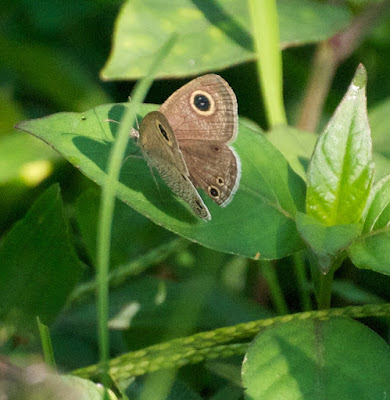You can see any number of interesting things if you don't rush; shortly after the rest took off to do some hiking, a Little Spiderhunter (Arachnothera longirostra) dropped in to give me a close look. Though it is the commonest of the spiderhunters, I haven't had many opportunities to photograph one, so I was grateful for this bird's apparent interest in me. For those unfamiliar with them, spiderhunters are glorified, usually oversized sunbirds - or, I should say, deglorified, because in all but the Purple-naped Spiderhunter (Hypogrammica hypogrammicum) they have lost all hints of iridescent colour (and because that one retained a bit of iridescent colour at the back of its neck, it was long considered to be a 'typical' sunbird until its DNA proved otherwise).
Birds aside, keeping your eyes on the ground (or at least the lower vegetation levels) is usually the best way to spot something - perhaps a spray of tiny yellow flowers arching over a bank. I've seen this plant many times, but this is the first time I've been able to put a name to it: Globba pendula, a common plant along Malaysian forest trails. Though it doesn't really look it, it is a miniature member of the ginger family. The flowers are not much bigger than the bees that pollinate them, and the whole plant is only about a metre tall.
You may spot an orange and black ant making its way over a leaf...
...with a nearby wasp sporting much the same colour pattern. Is mimicry involved? They are certainly very different in size!
Along the little stream you can find two common damselflies. This one is Copera marginipes. Notice the large, bright yellow legs, which the insects use to display to rivals or prospective mates. Damselflies have apparently been doing this for a long time - a related damselfly trapped in amber in the mid-Cretaceous, almost 100 million years ago, had greatly expanded, patterned tibiae seemingly adapted to do much the same thing.
This is Coeliccia albicauda, a particularly graceful little insect. The two species seem to have the stream to themselves - I scoured the place for additional damselflies, but never found them.
Skipper butterflies of the genus Notocrypta, found from India to Australia, are called 'demons' in English. I haven't the faintest idea why. There are six quite similar-looking species in Malaysia; this is probably the commonest, the Banded Demon (Notocrypta paralysos varians). For those confused by English butterfly names: the name "Banded Demon" is also used for the single species to reach tropical Australia, Notocrypta waigensis, which also happens to be the only Australian butterfly whose larvae feed on plants in the ginger family (Zingiberaceae). The Malaysian species feeds, instead, on members of a related plant family, the Costaceae.
Finding a skink peeping out from the undergrowth is easy - in fact, in Malaysian forests skinks can be hard to avoid. Identifying them is another matter, and I'm not even going to try with this one (well, I did try, but got nowhere). It is probably one of the sun skinks (Eutropis sp.).
I found this little bird sitting at the bottom of the steep muddy slope. It appeared to be unwell, but I was not able to reach it. The thing is, I haven't the faintest idea what this bird is, and other Malaysian birders I have shown it to can't identify it either. It may be a flycatcher, or if that yellow coloring on its belly is not just a stain from the mud, perhaps a flowerpecker of sorts. I doubt that it's anything rare or unusual – probably it is just a young bird freshly out of the nest, in a plumage that birders don't normally see.
Eileen, Chips, and Shirley were expecting to meet me by our car at the end of their walk, so I couldn't linger very long in the forest. Coming back out to the road, though, did give me a chance to photograph this Common Four-Ring (Yphthima huebneri), a widespread roadside butterfly.
The insect of the day, though, was far more spectacular: while I waited for the others, I found a highly cooperative male Common Birdwing (Troides helena cerberus) searching for nectar at a hibiscus bush (you can tell it is a male because females have a row of large black spots on the underwing).
I usually just see these huge butterflies - they are, I believe, the largest butterflies in Malaysia - sailing overhead, so being able to spend time at close range with this one was an unusual treat.
I indulged myself (and my camera) accordingly.
I indulged myself (and my camera) accordingly.
Birdwings are primarily forest butterflies, but this one - like me - had a reason to leave the forest in he heat of the day. Waiting around is rarely as exciting as this!


























No comments:
Post a Comment